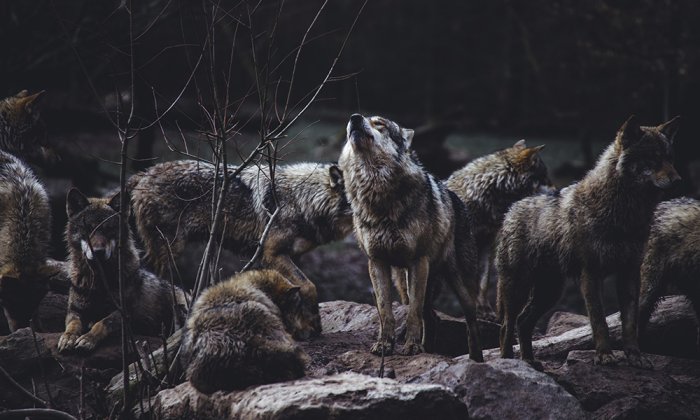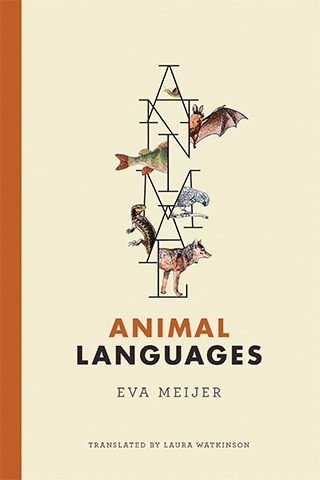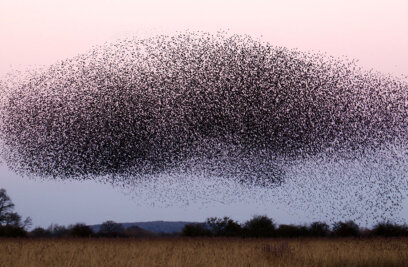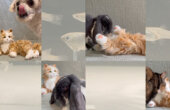From Parrot Dialects to Scent Signals: Understanding Animal Subjectivity Through Their Languages

Several years ago, there was big news: Dolphins call one another by name. Like humans, they all have a unique sound that they use to introduce themselves to new dolphins and to call one another. Dolphins are far from the only animals that have names. Parrots receive a name from their parents. Squirrel monkeys have a special “chuck” sound for each individual. Bats have names that they use to call one another so that they can stay together in the darkness. This can be particularly useful in a big group. A name is handy because it allows you to call someone else and to indicate that it is you who is coming.

Identity is not only communicated by voice. Hyenas live in fluid social relationships in which the females are dominant. In their interaction, they make use of scent signals from their anal glands, which occur in 252 different arrangements and form an individual profile that changes over time. The scents are also overwritten by other members of the group, which allows passing outsiders to form a good picture of both the individuals who live somewhere — their age, gender, status, health, perhaps their mood — and the strength of the group as a whole. With dogs, the scent from the anal glands — every dog lover knows it well — also provides a similar sort of profile. Urine and excrement provide information about identity too. Sometimes dogs in the city, who have never met before, seem to have an inexplicable antipathy towards each other; most likely they have long been aware of the other’s existence because of the traces of scent they have previously encountered, and they have some reason for hostility.
Parrots receive a name from their parents. Bats have names that they use to call one another so that they can stay together in the darkness.
Many animals make use of scent in excrement and urine. Hippos, for example, like to mark out their territory with dung, as do rabbits. Lobsters have little tubes under their eyes that are filled with urine, which they spray into others’ faces. The males do this when they are fighting. Lobsters fight often and remember who they have fought. They also have a mental map of who lives where. Only the strongest male mates with the females and female lobsters only mate when they have just shed their shells. They spray urine in the male’s face to daze him and they dance a little. During mating, the male protects the female, but when she has a new shell the male leaves, and the next female might come along. Females do not fight one another.
Like cats, snakes have a Jacobson’s organ. Located in the roof of the mouth, this is an organ of chemoreception that is part of the olfactory system, which these animals use to smell. Their tongues capture scent particles that they place in the Jacobson’s organ, which has two openings, allowing them to smell the world in stereo. Snakes use this to find both predators and prey, and to communicate with other snakes. The trail that their body leaves behind and the air that they pass through contain pheromones with information about their gender and age, and whether they are pregnant. Young snakes follow this trail to find the location of the shared hibernation space. Puff adders, venomous snakes found mainly in southern Africa, not only leave behind scents for others to follow but also camouflage their own scent in order to deceive predators. Snakes also communicate by touch, and some cobras make low growls.
Wolves make use of similar scent signals to dogs. In addition, they howl. Both in the frequency and in the harmony, they give clues about their own identity and about their relationships; wolves howl or sing longer and louder to wolves with whom they have a stronger bond. Their howls probably share information with each other, but we do not yet know precisely what. Coyotes sing and share information about their identity as well. The howling of coyotes is also a way to call members of their own group and to let other packs know that they are there.
Dingos — Australian feral dogs that are genetically somewhere between the wolf and the dog — can both bark and howl. They bark rarely, their barking is shorter than that of domestic dogs and they sing less than wolves. Howling can be an individual matter (to discuss food or hierarchy) and because the sound travels over long distances it is a good way to communicate in the Australian wilderness. Dingos also sing in groups, as an expression of pleasure, to warn others and to communicate with other groups about the size of the pack without having to engage in a confrontation. When more dingos are singing, the frequency rises.
Within species, different groups of animals sometimes have their own dialect. The songs of whales differ from group to group. Sometimes whales pick up a popular song from a certain group and it becomes a hit in that group too. Parrots live in communities of 20 to 300 animals, which all have different dialects. Some parrots can speak the dialect of more than one group. The territories of the white-crowned sparrow are so sharply defined that when you stand on the border you can hear one dialect in the songs on the left and another on the right.
Parrots live in communities of 20 to 300 animals, which all have different dialects.
Great tits have dialects too, and research has also been carried out into their transmission of social norms. Captive tits were taught to use a red or blue door to open a food cage containing a mealworm, a particular delicacy for these birds. Then the birds were released into a wild population, which they quickly taught how to get the mealworm. Small trackers recorded which birds reached the mealworm and through which door. Twenty days later, three-quarters of the population understood how it worked, and the vast majority chose the door that had been taught to the first bird. When the cage was removed and put back a year later, the birds immediately started using the same door again. This is remarkable, as three-fifths of the birds from the original population had died in the meantime. The researchers believe that social norms probably also exist in other animals that live in stable social groups; behavioral innovation, passing on new skills, helps populations to survive.
To determine whether animals are aware of who they are, or of the fact that they are someone, researchers have developed the mirror test. This test involves sticking a red dot to the animal’s forehead and placing the animal in front of a mirror. If the animal attempts to remove the dot from his or her forehead, this is an indication of self-awareness — that is, the animals are able to recognize themselves as selves in the mirror. Elephants, magpies, chimpanzees, pigs, and many other animals have been found to have this self-awareness.
There are problems with the mirror test though: First, there are some animals who do not mind having a sticker on their skin. Second, in some cultures looking at yourself in the mirror is not good form. Third, it is not that suitable for animals whose other senses are more important than sight.
To start with the first point: Elephants use mud to keep cool and to prevent itching, so they often do not object to a little thing like a sticker on their skin and therefore score badly in the mirror test, in spite of their intelligence and socially minded attitude. We find the second, cultural aspect in gorillas, who are social animals and assumed to be self-aware, but they are naturally shy and long eye contact is not common among their kind, so they too score badly on the mirror test. The same applies, incidentally, to children from some non-Western cultures. Out of 82 children from Kenya, only two passed the test, whereas Western children pass the test almost without exception — clearly the difference here is cultural, not cognitive. Thirdly, the test is also not very suitable for animals whose sight is not good. Dogs are more focused on scent than on sight, so animal ethologist Marc Bekoff came up with the yellow snow test, a variation on the mirror test. Dogs live in a universe of scents, which inspired Bekoff to carry out an experiment in which he collected pee from the snow and investigated how his dog reacted. The dog in question, Jethro, spent considerably less time sniffing his own pee than that of other dogs, so he was clearly reacting differently to the scent profile of other dogs than to his own.
These examples show us that there is more going on in the social lives of animals than we may think. Looking at their languages can help us to better understand their inner lives. However, as the mirror test demonstrates, there are also problems with research methods that are based on human capacities: Human bias distorts how we view other animals. Similarly, if we only study the languages of other animals on the basis of how much they resemble human language, many animals will not fare well. In order to move beyond anthropocentrism, power relations in research need to be taken into account, and we need to develop new research practices together with other animals. In this process, existing concepts such as language can be a starting point.
Eva Meijer is an author and philosopher. She is author of, among other books, “Bird Cottage,” a novel, “When Animals Speak: Toward an Interspecies Democracy,” “The Limits of My Language: Meditations on Depression,” and “Animal Languages,” from which this article is excerpted.




